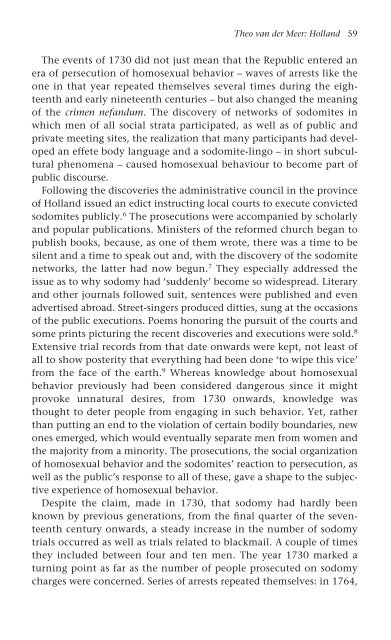queer masculinities
queer masculinities
queer masculinities
Create successful ePaper yourself
Turn your PDF publications into a flip-book with our unique Google optimized e-Paper software.
Theo van der Meer: Holland 59<br />
The events of 1730 did not just mean that the Republic entered an<br />
era of persecution of homosexual behavior – waves of arrests like the<br />
one in that year repeated themselves several times during the eighteenth<br />
and early nineteenth centuries – but also changed the meaning<br />
of the crimen nefandum. The discovery of networks of sodomites in<br />
which men of all social strata participated, as well as of public and<br />
private meeting sites, the realization that many participants had developed<br />
an effete body language and a sodomite-lingo – in short subcultural<br />
phenomena – caused homosexual behaviour to become part of<br />
public discourse.<br />
Following the discoveries the administrative council in the province<br />
of Holland issued an edict instructing local courts to execute convicted<br />
sodomites publicly. 6 The prosecutions were accompanied by scholarly<br />
and popular publications. Ministers of the reformed church began to<br />
publish books, because, as one of them wrote, there was a time to be<br />
silent and a time to speak out and, with the discovery of the sodomite<br />
networks, the latter had now begun. 7 They especially addressed the<br />
issue as to why sodomy had ‘suddenly’ become so widespread. Literary<br />
and other journals followed suit, sentences were published and even<br />
advertised abroad. Street-singers produced ditties, sung at the occasions<br />
of the public executions. Poems honoring the pursuit of the courts and<br />
some prints picturing the recent discoveries and executions were sold. 8<br />
Extensive trial records from that date onwards were kept, not least of<br />
all to show posterity that everything had been done ‘to wipe this vice’<br />
from the face of the earth. 9 Whereas knowledge about homosexual<br />
behavior previously had been considered dangerous since it might<br />
provoke unnatural desires, from 1730 onwards, knowledge was<br />
thought to deter people from engaging in such behavior. Yet, rather<br />
than putting an end to the violation of certain bodily boundaries, new<br />
ones emerged, which would eventually separate men from women and<br />
the majority from a minority. The prosecutions, the social organization<br />
of homosexual behavior and the sodomites’ reaction to persecution, as<br />
well as the public’s response to all of these, gave a shape to the subjective<br />
experience of homosexual behavior.<br />
Despite the claim, made in 1730, that sodomy had hardly been<br />
known by previous generations, from the final quarter of the seventeenth<br />
century onwards, a steady increase in the number of sodomy<br />
trials occurred as well as trials related to blackmail. A couple of times<br />
they included between four and ten men. The year 1730 marked a<br />
turning point as far as the number of people prosecuted on sodomy<br />
charges were concerned. Series of arrests repeated themselves: in 1764,


